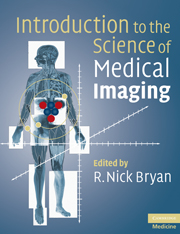Book contents
- Frontmatter
- Contents
- List of contributors
- Introduction
- Section 1 Image essentials
- Section 2 Biomedical images: signals to pictures
- Section 3 Image analysis
- 11 Human observers
- 12 Digital image processing: an overview
- 13 Registration and atlas building
- 14 Statistical atlases
- Section 4 Biomedical applications
- Appendices
- Index
- References
14 - Statistical atlases
Published online by Cambridge University Press: 01 March 2011
- Frontmatter
- Contents
- List of contributors
- Introduction
- Section 1 Image essentials
- Section 2 Biomedical images: signals to pictures
- Section 3 Image analysis
- 11 Human observers
- 12 Digital image processing: an overview
- 13 Registration and atlas building
- 14 Statistical atlases
- Section 4 Biomedical applications
- Appendices
- Index
- References
Summary
The widespread use of medical imaging as a means for diagnosis and monitoring of diseases, as well as for offering prognostic indicators, has enabled the collection of large imaging databases from healthy and diseased populations. Although earlier advanced imaging studies typically involved a few dozen subjects each, many current clinical research studies involve hundreds, even thousands of participants, often with multiple scans each. This has created a significant demand for quantitative and highly automated methods for population-based image analysis.
In order to be able to integrate images from different individuals, modalities, and time points, the concept of a statistical atlas (Figure 14.1) has been introduced and used extensively in the medical image analysis literature, especially in the fields of computational anatomy and statistical parametric mapping of functional brain images. An atlas reflects the spatiotemporal characteristics of certain types of images for specific populations. For example, a statistical atlas of the typical regional distribution of gray and white matter (GM, WM) in the brain can be constructed by spatially normalizing a number of brain images of healthy individuals into a common stereotaxic space, and measuring the mean and standard deviation of the amount of GM and WM in each brain region (Figure 14.2). This atlas can also be more specific, for example, as to age, gender, and other characteristics of the underlying population.
- Type
- Chapter
- Information
- Introduction to the Science of Medical Imaging , pp. 240 - 250Publisher: Cambridge University PressPrint publication year: 2009

